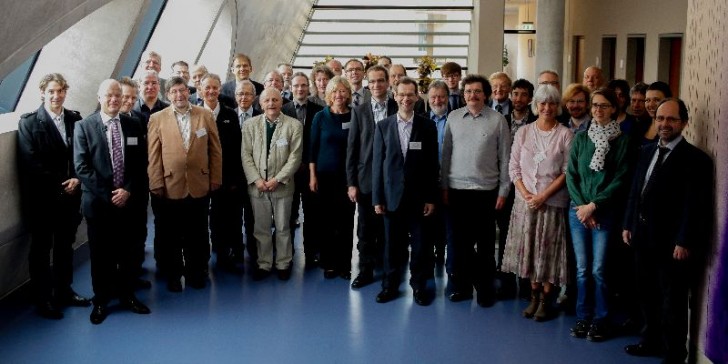8th Intl. Nano-Authorities Dialogue hosted by the BMUB

At the invitation of the German Federal Ministry for the Environment, Nature Conservation, Building and Nuclear Safety (BMUB), delegates of ministries, authorities and research institutes met in Berlin on May 14 and 15 to discuss the topic "nanomaterials and the environment”. The International Nano-Authorities Dialogue is held annually and takes place in one of the participating German-speaking countries. It is organised and moderated by the Innovation Society, St. Gallen. Its purpose is the exchange of views on the latest developments in the field of nano-regulation.
(Berlin / St. Gallen, May 19th 2014)
On the 14th and 15th of May, the 8th International Nano-Authorities Dialogue took place in Berlin. The German Federal Ministry for the Environment, Nature Conservation, Building and Nuclear Safety (BMUB) hosted the event and invited delegates of ministries, authorities and research institutes from Germany, Austria, Liechtenstein and Switzerland. This year’s nano-dialogue was dedicated to the topic “nano and environment” and included an exchange of information on applications and market data of nanomaterials, fluxes and behaviour of nanomaterials in the environmental compartments (air, water, sediment, soil) as well as risk assessment and derived regulatory approaches.
The Nano-Authorities Dialogue is an annually held dialogue platform of environmental, health and safety agencies as well as scientists from German-speaking countries. The purpose of this platform is the informal, cross-border information and experience exchange on current issues related to nano-governance. On behalf of the authorities, the annual Nano-Authorities Dialogue series has been organised by The Innovation Society, St. Gallen since 2008.
Market overview and environmental behaviour of nanomaterials
Martin Möller (Öko-Institut, Freiburg) presented an overview of up-to-date data on the turnover of nanomaterials. The volume of the global trade of nanomaterials is about to reach an estimated 20 Billion US-Dollars and is constantly increasing. More and more consumer products are available on the market. Due to the lack of declaration of nanomaterials in products, market transparency continues to be poor. Consequently, finding answers to questions regarding the quantity and type of nanomaterials released into the environment is becoming an urgent issue. Other questions regard the behaviour of nanomaterials in the environment and their impacts thereon. At the same time, Martin Möller emphasized the potential for environmental benefits of nanomaterials, which should also be taken into account.
Information about environmental behaviour as well as the potential for environmental benefits can be assessed, for example, using life cycle assessments, Prof. Arnim von Gleich (Universität Bremen) stated. It is crucial, however, that the entire life cycle of products is taken into consideration and that a toxicological risk assessment is included in the assessment. Yet, large data gaps hamper the realisation of said assessments. In the opinion of the BMUB, more market transparency - which could be established by implementing a European nano-product register - is required.
Resorting to two concrete examples, Dr. Hubert Rauscher (European Commission, Joint Research Centre, Ispra) presented possible approaches and open questions regarding grouping of nanomaterials. Nanomaterials are usually used in various sizes, shapes and with different (surface) modifications. Consequently, their properties, applications and their environmental behaviour may vary considerably. Meaningful ways to group nanomaterials based on their behaviour could reduce the burden of registration under REACH for both manufacturers and authorities. However, to date it remains unclear how this issue could be addressed.
Dr. Kathrin Schwirn (Federal Environment Agency (UBA), Dessau-Rosslau) provided an overview of the challenges and knowledge gaps regarding ecotoxicological risk assessment. The effects of nanomaterials on organisms differ from those of bulk materials. Hence, the investigation of nanomaterials in test methods requires special provisions, for example regarding dispersion. The OECD develops recommendations and tools for environmental risk assessments and promotes the exchange on regulatory approaches. This includes the development of test guidelines applicable to nanomaterials.
Behaviour of nanomaterials in environmental compartments
To measure airborne concentrations of nanomaterials, a distinction from other potentially health-relevant materials is necessary, Dr. Dirk Dahmann (Institut für Gefahrstoff-Forschung, University of Bochum) stated. The question which analytical parameter should be used for the toxicological assessment of nanomaterials is still under debate. Recent findings suggest that the particle surface is probably better suited as an analytical parameter than the mass or number of particles.
Dr. Frank von der Kammer (University of Vienna) gave insights into the behaviour of nanomaterials in water, sediments and soils. Many nanomaterials tend to agglomerate, aggregate or adsorb to sediment and soil particles and thus become less bioavailable. However, further research is needed regarding the behaviour of nanomaterials in landfills, where a large share of the nanomaterials is disposed of, and with regard to the measurement of hetero-agglomerates.
International regulation
In the concluding presentation, Prof. Dr. Thomas Cottier (World Trade Institute, University of Berne) put the topic “nano governance” in an international context. Among other things, he discussed the compatibility of precautionary labels and product declarations under commercial law in the light of the agreements of the World Trade Organization (WTO) and current discussions on (transatlantic) free trade agreements. Regulatory measures are permitted under these contracts, but the principle of proportionality has to be ensured and equal treatment with nationals needs to be complied - also and especially de facto.
The presentations and discussions at this year's nano-authorities dialogue made it clear that there are still many open issues related to nanomaterials in the environment and in consumer products. In the view of the above, solutions should not only be pushed at a national but also at a global level. The international dialogue between authorities represents an important tool for a common problem-solving approach and will be continued. The 9th Int. Nano-Authority-Dialogue will take place in spring 2015 at the invitation of the Federal Ministry for the Environment in Vaduz, Liechtenstein.
Contact and further information:
The Innovation Society, St. Gallen
Dr. Christoph Meili
Lerchenfeldstr. 5
CH-9014 St. Gallen
Tel: +41 71 278 02 06
BMUB website on nanotechnology: http://www.bmub.bund.de/en/topics/health-chemical-safety-nanotechnology/nanotechnology/